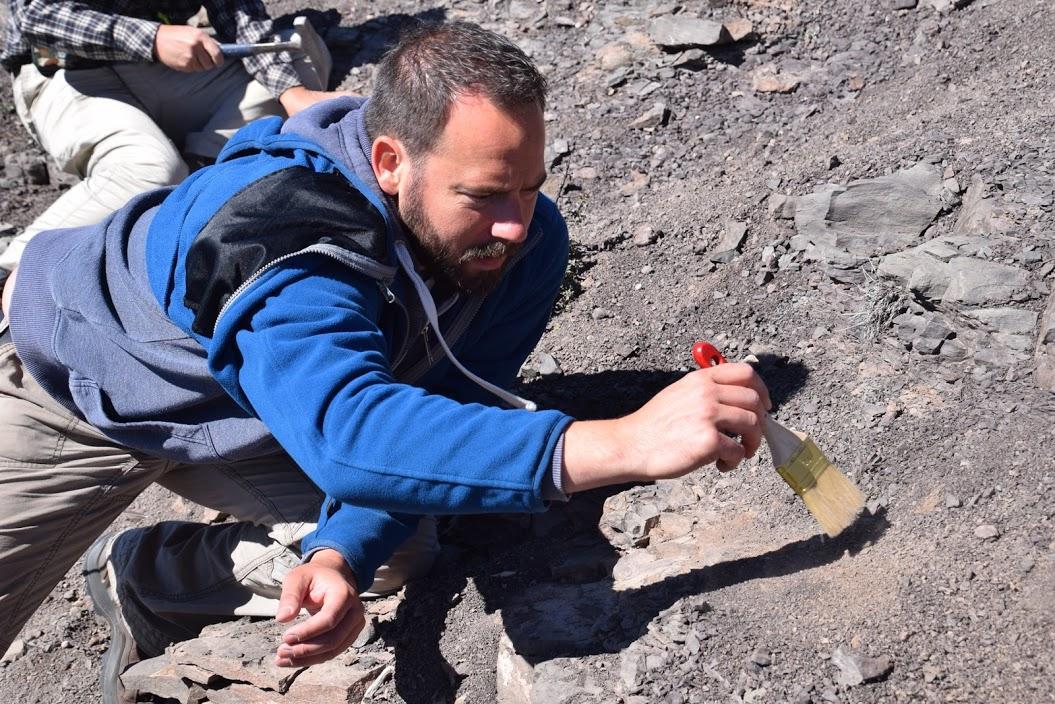Reasearch questions
The origin and early evolution of amniotes, the clade that includes all fully terrestrial tetrapods, led to major changes in the structure and hierarchy of terrestrial vertebrate ecosystems, including the evolution of high-fiber herbivory, entirely new locomotor strategies such as climbing and flying, and ultimately the evolution of modern terrestrial ecosystems. My research focuses on the patterns of diversification, phylogeny, and paleobiology early amniotes, with special focus on the Synapsida, the clade that ultimately led to the evolution of mammals. The application of different approaches combines paleontological fieldwork with modern techniques (3D-imaging) and quantitative methods to shed new light on the early patterns of diversification of major vertebrate clades and the evolution of key innovations. Ultimately, our research aims to quantitatively investigate the evolution of terrestrial ecosystems, as well as to gain a better understanding of the impact of mass extinction events on terrestrial vertebrate ecosystems
Duration
Until 2020
Funding
German Research Foundation - DFG
Partners
- Dr. Kenneth D. Angielczyk, The Field Museum of Natural History, Chicago, USA
- Dr. Juan C. Cisneros, Universidade Federal do Piauí, Teresina, Brazil
- Dr. Christian F. Kammerer, North Carolina Museum of Natural Sciences, Raleigh, USA
- Dr. Claudia Marsicano, Universidad de Buenos Aires, Argentina
- Prof. Emily Rayfield, University of Bristol, UK
- Prof. Robert R. Reisz, University of Toronto, Canada
- Dr. Martha Richter, Natural History Museum, London, UK
- Prof. Bruce Rubidge, University of the Witwatersrand, Johannesburg, South Africa
- Prof. Dr. P. Martin Sander, Rheinische Friedrich-Wilhems-Universität Bonn
- Prof. Dr. Lars Schmitz, W.M. Keck Science Department, Claremont, USA
- Dr. Roger M. H. Smith, Iziko, The South African Museum, South Africa
Selected publications
- Romano, M., Brocklehurst, N., and Fröbisch, J. (2017) Discrete and continuous character-based disparity analyses converge to the same macroevolutionary signal: a case study from captorhinids. – Scientific Reports 7: 17531.
- Brocklehurst, N., Day, M. O., Rubidge, B. S., and Fröbisch, J. (2017) Olson’s Extinction and the latitudinal biodiversity gradient of tetrapods in the Permian. – Proceedings of the Royal Society B 284: 20170231.
- Verrière, A., Brocklehurst, N., and Fröbisch, J. (2016) Assessing the completeness of the fossil record: comparison of different methods applied to parareptiles (Tetrapoda, Sauropsida). – Paleobiology 42 (4): 680–695.
- Brocklehurst, N., Ruta, M., Müller, J., and Fröbisch, J. (2015) Elevated extinction rates as a trigger for diversification rate shifts: early amniotes as a case study. – Scientific Reports 5: 17104.
- Cisneros, J. C., Marsicano, C., Angielczyk, K. D., Smith, R. M. H., Richter, M., Fröbisch, J., Kammerer, C. F., and Sadleir, R. (2015) New Permian fauna from tropical Gondwana. – Nature Communications 6: 8676.
- C. F. Kammerer, K. D. Angielczyk, and J. Fröbisch (2014) Early Evolutionary History of the Synapsida. Berlin/Heidelberg (Springer): 337 pp.
- Reisz, R. R. and Fröbisch, J. (2014) The oldest caseid synapsid from the late Pennsylvanian of Kansas, and the evolution of herbivory in terrestrial vertebrates. – PLoS ONE 9 (4): e94518.
- Fröbisch, J. (2013) Vertebrate diversity across the end-Permian extinction – separating biological and geological signals. – Palaeogeography, Palaeoclimatology, Palaeoecology 372: 50-61.
- Fröbisch, N. B., Fröbisch, J., Sander, P. M., Schmitz, L., and Rieppel, O. (2013) A Middle Triassic macropredatory ichthyosaur and the origin of modern trophic networks. – Proceedings of the National Academy of Sciences of the United States of America 110 (4): 1393–1397.
- Kammerer, C. F., Angielczyk, K. D., and Fröbisch, J. (2011) A comprehensive taxonomic revision of Dicynodon (Therapsida: Anomodontia) and its implications for dicynodont phylogeny, biogeography, and biostratigraphy. – Journal of Vertebrate Paleontology, Memoir 31(S1): 1-157.
- Fröbisch, J., Angielczyk, K. D., and Sidor, C. A. (2010) The Triassic dicynodont Kombuisia (Synapsida, Anomodontia) from Antarctica, a refuge from the terrestrial Permian-Triassic mass extinction. – Naturwissenschaften 97: 187-196.
- Fröbisch, J. and Reisz, R. R. (2009) The Late Permian herbivore Suminia and the early evolution of arboreality in terrestrial vertebrate ecosystems. – Proceedings of the Royal Society B 276: 3611-3618.
- Fröbisch, J. (2009) Composition and similarity of global anomodont-bearing tetrapod faunas. – Earth-Science Reviews 95 (3-4): 119-157.
- Fröbisch, J. (2008) Global taxonomic diversity of anomodonts (Tetrapoda, Therapsida) and the terrestrial rock record across the Permian-Triassic boundary. – PLoS ONE 3 (11): e3733.
